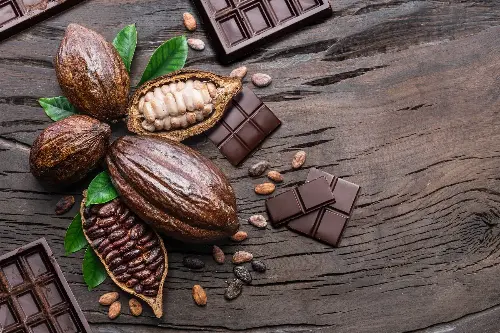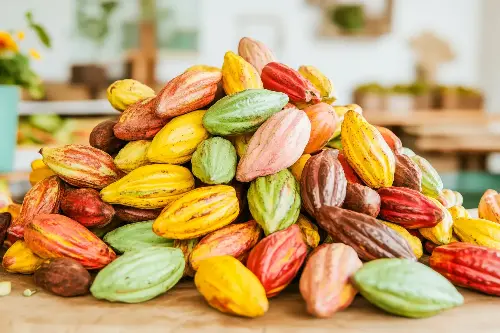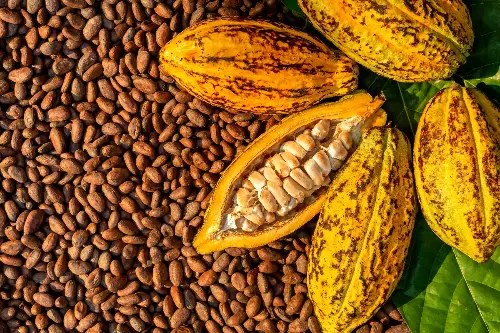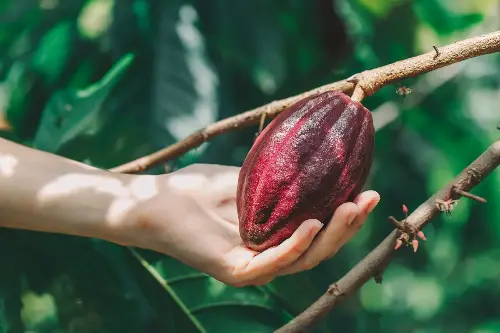The journey of chocolate begins with a small, but mighty hero: the cocoa bean. This cherished commodity has a storied past that traces back thousands of years. Originating from the deep tropical regions of the Americas, the Theobroma cacao tree, which literally means "food of the gods", was first cultivated by ancient Mesoamerican cultures. The Mayans and Aztecs revered this plant, using the beans not only to craft a frothy, bitter beverage but also as currency and in religious ceremonies. This association with divinity and wealth speaks volumes about the historical value placed upon cocoa, which continues to leave an indelible mark on societies across the globe.

The Surprising Life of a Cocoa Tree
Cocoa trees have a unique and rather mysterious pollination process that is crucial for the production of the cocoa beans. Unlike many plants, cocoa trees are not pollinated by bees or butterflies, but instead by tiny insects called midges. These creatures thrive in the humid, rainforest conditions that cocoa trees require, and their delicate work is essential for the sexual reproduction of the plant. In fact, only a small fraction of the flowers get pollinated, making the role of midges even more critical. The fertility of cocoa trees is quite an enigmatic aspect of their life cycle, and without the match-making midges, the chocolate industry would be far less sweet.
The Diversity of Cocoa
Cocoa beans come in several varieties, each with its own distinctive flavour profile. The primary types of cocoa are Criollo, Forastero, and Trinitario. Criollo, known as the "prince of cocoas," offers a complex, aromatic flavour and is less bitter than other types. However, they are more susceptible to diseases and constitute a mere 5% of the world’s cocoa production, making them a rare gem in the chocolate world. Forastero, on the other hand, is the hardy workhorse of the cocoa family, representing the vast majority of cocoa production due to its robust nature. Lastly, Trinitario is a hybrid of Criollo and Forastero and strikes a balance with good flavour and hardiness. These varieties are just the tip of the iceberg, as there are many sub-varieties and nuances within each type, waiting to be explored by chocolate connoisseurs.

The Labour of Love Behind Your Chocolate Bar
The process of turning raw cocoa beans into the chocolate bars we know and love is an intricate and labour-intensive process. After harvesting the pods by hand, farmers go through a meticulous process of fermentation and drying. Fermentation is a critical step that lasts about five to seven days and develops the beans' flavour. After fermentation, the beans are dried under the sun, a step that must be done carefully to prevent mould. Only once the beans are properly dried can they be packed and shipped to chocolate manufacturers around the world. These steps are crucial in fine-tuning the flavour profile of the chocolate and highlight the care and expertise needed to craft a bar of high-quality chocolate.
The Health Benefits of Cocoa
Long beyond its use as currency and a luxury drink for nobility, cocoa has been revealed to have various health benefits in its dark, unprocessed form. Rich in flavonoids, natural compounds with antioxidant properties, consuming cocoa has been linked to a wide range of benefits, including improved heart health and cognitive function. Research suggests that these antioxidants can help to reduce blood pressure and improve blood flow to the brain and heart. Moreover, dark chocolate, with a high cocoa content, is a source of minerals such as iron, magnesium, and zinc. Although the benefits of cocoa are no excuse to overconsume chocolate, particularly varieties high in sugar and fat, they do provide a delightful justification for a moderate, guilt-free indulgence in a piece of dark chocolate.

The Socioeconomic Impact of Cocoa Farming
The humble cocoa bean is not only a treat to our taste buds but also a significant crop for millions of farmers around the globe. The majority of the world's cocoa is produced by smallholder farmers in West Africa, with Côte d'Ivoire and Ghana being the largest producers. For these farming communities, cocoa is the main source of income. However, the industry is not without its challenges. Issues like fair pay, child labour, and sustainable farming practices are at the forefront of the global conversation about cocoa. Chocolate companies and consumers increasingly recognise the importance of ethically sourced chocolate and are supporting initiatives to improve the conditions of farming communities. This movement seeks to ensure that the enjoyment of chocolate is not only a treat for consumers but also brings benefits to the people who make it all possible.

In conclusion, cocoa is not just another crop; it is a cultural phenomenon that spans the globe, cuts through social classes, and connects us with ancient history. From the sensual pollination by midges to the uniquely complex flavour profiles, the cocoa bean harbours an abundance of surprises. By acknowledging the meticulous journey from flower to chocolate bar, understanding the nutritional benefits of dark chocolate, and recognising the societal importance of ethical cocoa farming, we deepen our appreciation for every velvety bite. Chocolate is more than just a treat; it is an intricate world teeming with history, diversity, and a potential for positive global impact.
